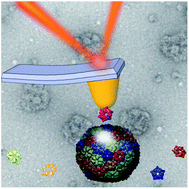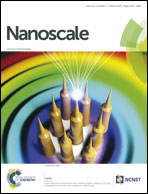The interplay between mechanics and stability of viral cages†
Abstract
The stability and strength of viral nanoparticles are crucial to fulfill the functions required through the viral cycle as well as using capsids for biomedical and nanotechnological applications. The mechanical properties of viral shells obtained through Atomic Force Microscopy (AFM) and continuum elasticity theory, such as stiffness or Young's modulus, have been interpreted very often in terms of stability. However, viruses are normally subjected to chemical rather than to mechanical aggression. Thus, a correct interpretation of mechanics in terms of stability requires an adequate linkage between the ability of viral cages to support chemical and mechanical stresses. Here we study the mechanical fragility and chemical stability of bacteriophage T7 in two different maturation states: the early proheads and the final mature capsids. Using chemical stress experiments we show that proheads are less stable than final mature capsids. Still, both particles present similar anisotropic stiffness, indicating that a continuum elasticity description in terms of Young's modulus is not an adequate measure of viral stability. In combination with a computational coarse-grained model we demonstrate that mechanical anisotropy of T7 emerges out of the discrete nature of the proheads and empty capsids. Even though they present the same stiffness, proheads break earlier and have fractures ten times larger than mature capsids, in agreement with chemical stability, thus demonstrating that fragility rather than stiffness is a better indicator of viral cages' stability.


 Please wait while we load your content...
Please wait while we load your content...